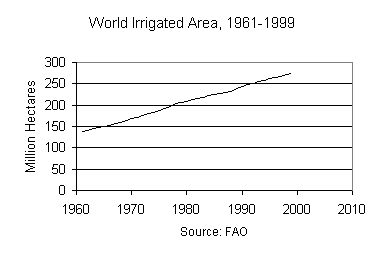“A terrific book from the sustainability pioneer Lester Brown.” —Bill Hewitt, FPA's Climate Change Blog
Click here to view the most recent Water Resources Indicator and Data
Water scarcity may be the most underestimated resource issue facing the world today. As world water demand has more than tripled over the last half-century, signs of water scarcity have become commonplace. Some of the more widespread indicators are rivers running dry, wells going dry, and lakes disappearing.

Among the rivers that run dry for part of the year are the Colorado in the United States, the Amu Darya in Central Asia, and the Yellow in China. China's Hai and Huai rivers have the same problem from time to time, and the flow of the Indus River—Pakistan's lifeline—is sometimes reduced to a trickle when it enters the Arabian Sea.
The Colorado River, the largest in the southwestern United States, now rarely makes it to the sea. As the demand for water increased over the years, diversions from the river have risen to where they now routinely drain it dry.
A similar situation exists in Asia, where the Amu Darya—one of the two rivers feeding the Aral Sea—now is dry for part of each year. With the sharp decline in the amount of water delivered to the Aral Sea by the Amu Darya, the sea has begun to shrink. There is a risk that the Aral could one day disappear entirely, existing only on old maps.
China's Yellow River, the northernmost of its two major rivers, first ran dry for a few weeks in 1972. Since 1985, it has failed to make it to the Yellow Sea for part of almost every year. Sometimes the river does not even reach Shandong, the last province it flows through en route to the sea. As water tables have fallen, springs have dried up and some rivers have disappeared entirely. China's Fen River, the major watercourse in Shanxi Province, which once flowed through the capital of Taiyuan and merged with the Yellow, no longer exists.
Another sign of water scarcity is disappearing lakes. In Central Africa, Lake Chad has shrunk by some 95 percent over the last four decades. Reduced rainfall, higher temperatures, and some diversion of water from the streams that feed Lake Chad for irrigation are contributing to its demise. In China, almost 1,000 lakes have disappeared in Hebei Province alone.
Water tables are falling in several of the world's key farming regions, including under the North China Plain, which produces nearly one third of China's grain harvest; in the Punjab, which is India's breadbasket; and in the U.S. southern Great Plains, a leading grain-producing region.
Water shortages now plague almost every country in North Africa and the Middle East. Algeria, Egypt, Iran, and Morocco are being forced into the world market for 40 percent or more of their grain supply. As population continues to expand in these water-short nations, dependence on imported grain is rising.
Iran, one of the most populous countries in the Middle East, with 70 million people, is facing widespread water shortages. In the northeast, Chenaran Plain—a fertile agricultural region to the east of Mashad, one of Iran's largest and fastest-growing cities—is fast losing its water supply. Wells drawing from the water table below the plain are used for irrigation and to supply water to Mashad. The latest official estimate shows the water table falling by 8 meters in 2001 as the demand for water far outstrips the recharge rate of aquifers.
Falling water tables in parts of eastern Iran have caused many wells to go dry. Some villages have been evacuated because there is no longer any accessible water. Iran is one of the first countries to face the prospect of water refugees—people displaced by the depletion of water supplies.
In Yemen, a country of some 19 million people, water tables are falling everywhere by 2 meters or more a year. In the basin where the capital Sana'a is located, extraction exceeds recharge by a factor of five, dropping the water table by 6 meters (about 20 feet) a year. Recent wells drilled to a depth of 2 kilometers (1.3 miles) failed to find any water. In the absence of new supplies, the Yemeni capital will run out of water by the end of this decade.
Another way of looking at water security is the amount of water available per person in a country. In 1995, 166 million people lived in 18 countries where the average supply of fresh water was less than 1,000 cubic meters a year—the amount deemed necessary to satisfy basic needs for food, drinking water, and hygiene. By 2050, water availability per person is projected to fall below the 1,000-cubic-meter benchmark in some 39 countries. By then, 1.7 billion people will in effect be suffering from hydrological poverty.
At some point, the combination of aquifer depletion and the diversion of irrigation water to cities will likely begin to reduce the irrigated area worldwide. Data compiled by the U.N. Food and Agriculture Organization, based on official data submitted by governments, show irrigated area still expanding. For example, between 1998 and 1999, the last year for which global data are available, irrigated area grew from 271 to 274 million hectares. (See Figure.) This reported 1-percent growth would be reassuring, but it appears to be overstated since governments are much better at gathering data on new irrigation projects than on irrigation reductions as water is diverted to cities or aquifers are depleted. It is quite possible that the historical growth in world irrigated area has come to a halt, and the area could even be declining.
Copyright © 2002 Earth Policy Institute


 Print:
Print:  Email
Email
